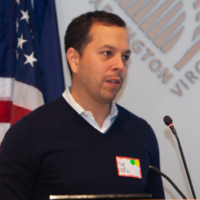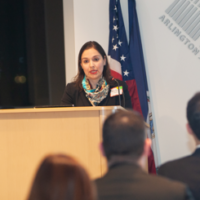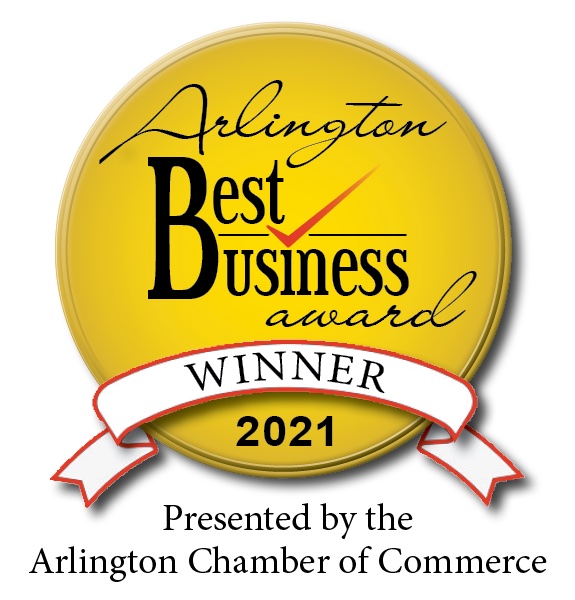
Potential Energy DC (PEDC) and Leaders in Energy hosted their sixth annual green financing forum on Thursday, January 23. This year’s event, “Green Project Financing for Growth” was a sell-out, and looking at the program it’s no surprise. Program planners for the two organizations brought together a veritable brain trust of green bank, finance, and energy industry leaders who discussed a wide variety of issues and provided insights into best practices.
The second panel of the program, “Case Studies: Project Financing for Growing Small & Medium-sized Companies”, was moderated by Dave McCarthy, Executive Director, PEDC. This portion of the program featured Timothy Effio, Market Director, Fluence & Commissioner, Environment and Energy Conservation Commission, Arlington County; Maria Goravanchi, Director, US International Development Finance Corporation (DFC), formerly Overseas Private Investment Corporation; and, Jack K. Sterne, Esq., Principal, Lumenant LLC.
Timothy Effio led off with an overview of the creation of Fluence, an energy storage joint venture of AES and Siemens. Financing, Effio stated, was what allowed the newly created company to put energy storage projects on the ground. This in turn lent credibility to a very complex technology that fits into many different parts of the grid, such as generation and behind-the-meter activity, in addition to being a valuable stand-alone technology. Given this complexity, banks sometimes have a hard time understanding how its revenues operate or even what they are. Fluence’s earliest projects, such as those in Chile, hinged on securing solid financing; in this case being rolled into a larger AES project dealing with thermal plants. This first project allowed Fluence to put approximately 15 MW on to the grid. Fluence built upon this success with an entree to the frequency regulation market at PJM, which began to provide a regular revenue stream.

Timothy Effio, Fluence
A major catalyst continued to be AES which provided balance sheet financing for Fluence to build out another 50 MW worldwide, including in Asia, Europe, India, and Latin America. These projects accessed revenue streams, in this case savings, that were at the time novel. A key moment came when California utilities began to explore storage as a way to move solar energy from one time of day to another, a project that Fluence successfully took on. Effio noted that since Fluence’s creation, financing for these kinds of companies and their projects has become more commonplace.
Jack Sterne followed Timothy with a presentation about his energy efficiency company Lumenant. Started in 2016, by 2017 it had $200,000 in revenue, by 2018 had reached $3 million. They finished strong in 2019 with $7 million in revue and project between $10 to 12 million for 2020. Lumenant’s financing model Sterne explained is “energy efficiency as a service.” That is, it looks like a lease but is in fact a service plan whereby Lumenant assumes all the risk, installing the equipment, such as lights at a facility, and also taking on the responsibility for servicing it. Early on Lumenant worked with Sparkfund, a DC-based financing company, for its backing, and with its support hit the $3 million revenue mark. Soon after, through luck and perseverance, Lumenant struck a deal with Affinity Living Group, a senior-living company based in North Carolina to upgrade one of their facilities. Its success convinced Affinity to have Lumenant provide the same service to all of its 140 assisted living facilities. Sterne’s company has now grown to 18, with 14 or so doing the actual projects.

Jack K. Sterne, Lumenant LLC
Lumenant’s continued success necessitated that it look beyond Sparkfund for additional sources of financing; the company had begun to bump up against the concentration limit. As a result of Sterne and Lumenant’s involvement with PEDC, Sterne was introduced to Jigar Shah founder of Generate Capital, who worked with Sterne to create a term sheet and eventually signed a warehouse financing agreement that brought finance in-house. This was important to Lumenant as it allowed the company to expand its financing options as well as provide a recurring stream of revenue. Its clients’ payments now come directly to them, which in turn increases Lumenant’s valuation by approximately five times. Sterne credits Sparkfund’s creativity in working out a structure whereby it paid Lumenant’s suppliers directly, essentially extending its terms. Most recently Lumenant met with Brookdale, the largest operator of senior living facilities, and is working to install circadian lighting systems in all of their facilities. The bottom line for Lumenant is that the variety of financing sources allowed the company to grow, establish credibility in the market, and build upon that credibility to get more business.
Maria Goravanchi of the DFC rounded out the panel with some thoughts and examples of international green project financing. She began by noting that by a recent Act of Congress, the 2018 Better Utilization of Investments Leading to Development (BUILD) Act, the Overseas Private Investment Corporation along with USAID’s Development Credit Authority was combined to create a new agency named the US International Development Finance Corporation (DFC). The DFC she explained has three-pronged mission: first, to support economic development and mobilize private sector investment to advance development in emerging economies around the world; second, continue OPIC’s legacy of returning a profit to US taxpayers through its various financing tools; and, three, to support US foreign policy through catalyzation of US private investment through partnerships in regions of critical strategic importance.

Maria Goravanchi, US International Development Finance Corporation
DFC offers a variety of financing tools, a long-term debt financing, a legacy from OPIC, that now allows DFC to offer up to $500 million in debt financing per project. DFC has approximately $23 billion under management, whose capital is mobilizing the development of a wide range of projects including energy, infrastructure, financial services, and healthcare. Additionally, the DFC continues to offer political risk insurance that can help offset and mitigate risks in emerging markets such as political violence, government interference, or inconvertibility of currencies. Through its creation two new authorities granted the DFC are equity authority and technical assistance/grant authority. The new equity authority allows the DFC to deploy equity to strategic projects from a Congressionally approved pool of capital. Goravanchi noted that DFC seeks to partner with private US investors in emerging markets, as well as looks for bankable transactions that have a track record, and finally looks for transactions may be situated in an emerging market that also have positive development, social, and, environmental impacts.
She provided two examples of projects, that showed not only the range of financing amounts DFC provides, but also displayed the additional positive effects on the communities where the projects were done. At the smaller end of the financing spectrum, IDFC closed a $5 million project to support Greenlight Planet, a majority US-owned company that distributes pay-as-you-go solar home kits that are being predominantly deployed in Africa and Southeast Asia. The project is helping DFC meet its renewable energy targets but is also helping offset carbon emissions by reducing the use of kerosene for lighting and cooking. These kits also can provide an alternate source of income for the users.
On a larger scale, DFC financed an aggregate 100 MW solar PV project in El Salvador through its US-based client AES. It lent up to $50 million on the debt side with a loan term of approximately 18 years to support longer term financing in that region.
In closing, the panelists offered a variety of parting thoughts about financing. Effio advised companies to be as scrappy as they can in obtaining that first bit of project financing, noting that a company’s first project can open the door to other sources of financing. Sterne observed that there is a lot of money available for good projects, but the key is to use your available network to make new connections. Finally, Goravanchi advised companies not to feel discouraged if they feel they’re too small. Echoing Sterne, she stressed that she and her team at DFC have an extensive network among which may be a financing partner looking for their particular type of project or idea. This is especially true for US-based companies that are looking to do overseas projects.
Agustín Cruz is business management and strategy consultant based in Arlington, VA. He provides clients with expert insight and advice on partnership outreach and relationship management. Currently, he serves as the Director of Programming for Potential Energy DC, a Washington, DC-area clean energy and sustainability technology.



Leave a Reply